Detailed Risk Management Report and Analysis: Adani Coal Mines Project
VerifiedAdded on 2021/06/15
|20
|2207
|17
Report
AI Summary
This report provides a detailed analysis of the risk management strategies for the Adani coal mines project. It begins with an executive summary, followed by a discussion of the risk management methodology, including quantitative data analysis and the collection of primary data. The report then delves into risk assessment, covering identification tools and techniques, such as data gathering and analysis, and the use of meetings. A significant portion is dedicated to risk analysis, including a bow tie diagram. The report also presents a risk treatment schedule and plan, along with a risk action plan, and a stakeholder register. The discussion and recommendation section offers insights and conclusions based on the findings, supported by a comprehensive bibliography of relevant sources. The report emphasizes the importance of managing technical, environmental, legal, and social risks to ensure the project's efficient and effective delivery.
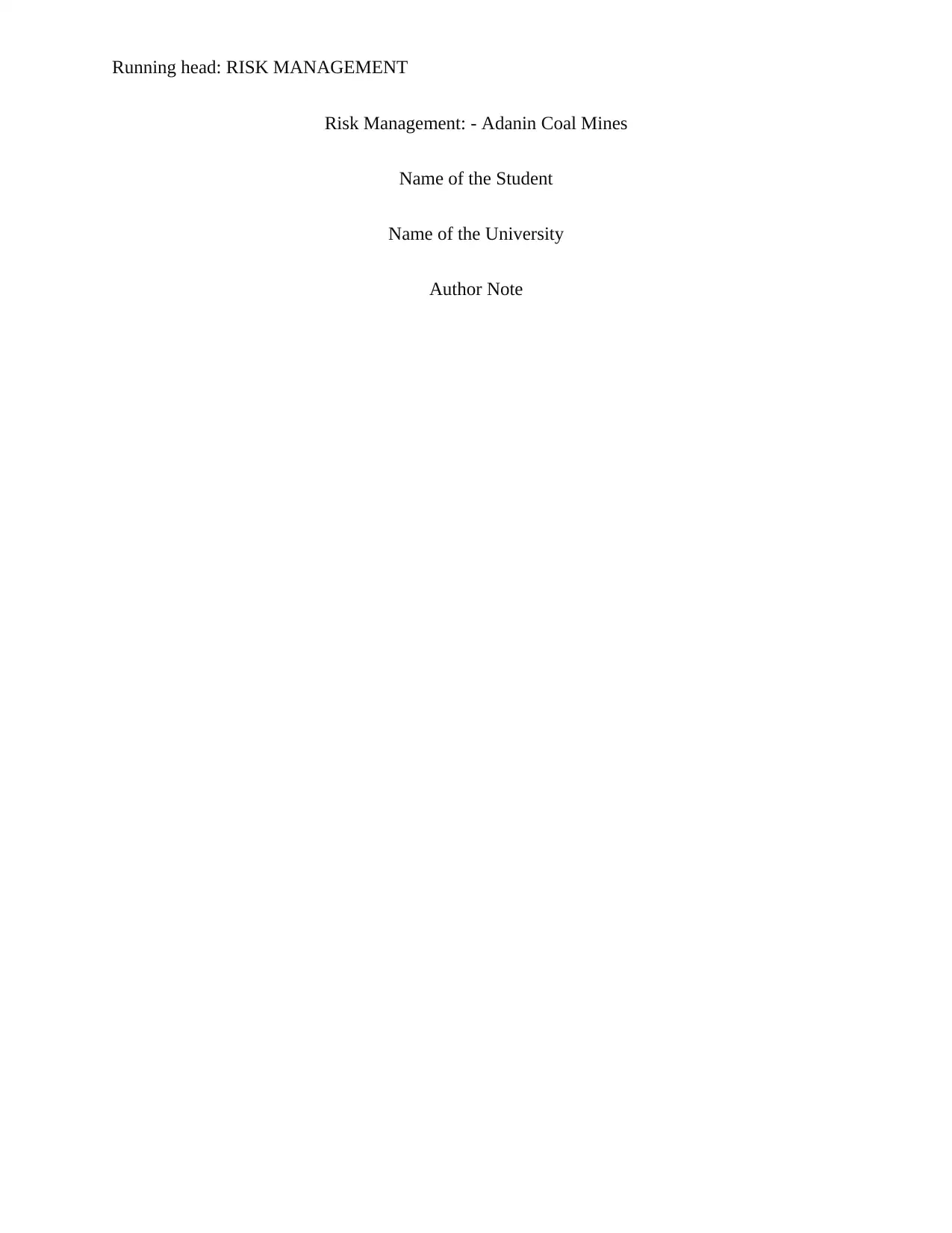
Running head: RISK MANAGEMENT
Risk Management: - Adanin Coal Mines
Name of the Student
Name of the University
Author Note
Risk Management: - Adanin Coal Mines
Name of the Student
Name of the University
Author Note
Paraphrase This Document
Need a fresh take? Get an instant paraphrase of this document with our AI Paraphraser
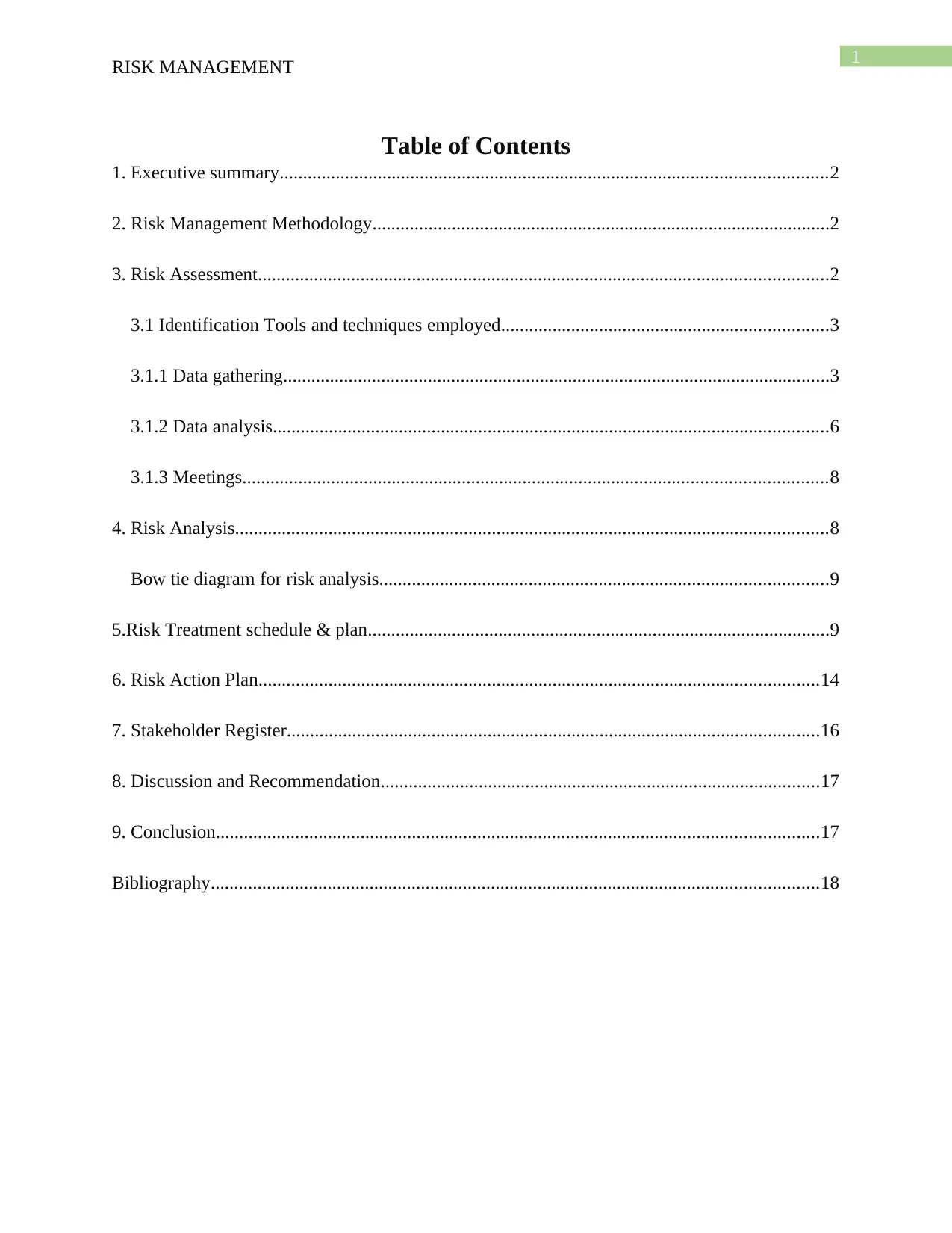
1
RISK MANAGEMENT
Table of Contents
1. Executive summary.....................................................................................................................2
2. Risk Management Methodology..................................................................................................2
3. Risk Assessment..........................................................................................................................2
3.1 Identification Tools and techniques employed......................................................................3
3.1.1 Data gathering.....................................................................................................................3
3.1.2 Data analysis.......................................................................................................................6
3.1.3 Meetings.............................................................................................................................8
4. Risk Analysis...............................................................................................................................8
Bow tie diagram for risk analysis................................................................................................9
5.Risk Treatment schedule & plan...................................................................................................9
6. Risk Action Plan........................................................................................................................14
7. Stakeholder Register..................................................................................................................16
8. Discussion and Recommendation..............................................................................................17
9. Conclusion.................................................................................................................................17
Bibliography..................................................................................................................................18
RISK MANAGEMENT
Table of Contents
1. Executive summary.....................................................................................................................2
2. Risk Management Methodology..................................................................................................2
3. Risk Assessment..........................................................................................................................2
3.1 Identification Tools and techniques employed......................................................................3
3.1.1 Data gathering.....................................................................................................................3
3.1.2 Data analysis.......................................................................................................................6
3.1.3 Meetings.............................................................................................................................8
4. Risk Analysis...............................................................................................................................8
Bow tie diagram for risk analysis................................................................................................9
5.Risk Treatment schedule & plan...................................................................................................9
6. Risk Action Plan........................................................................................................................14
7. Stakeholder Register..................................................................................................................16
8. Discussion and Recommendation..............................................................................................17
9. Conclusion.................................................................................................................................17
Bibliography..................................................................................................................................18
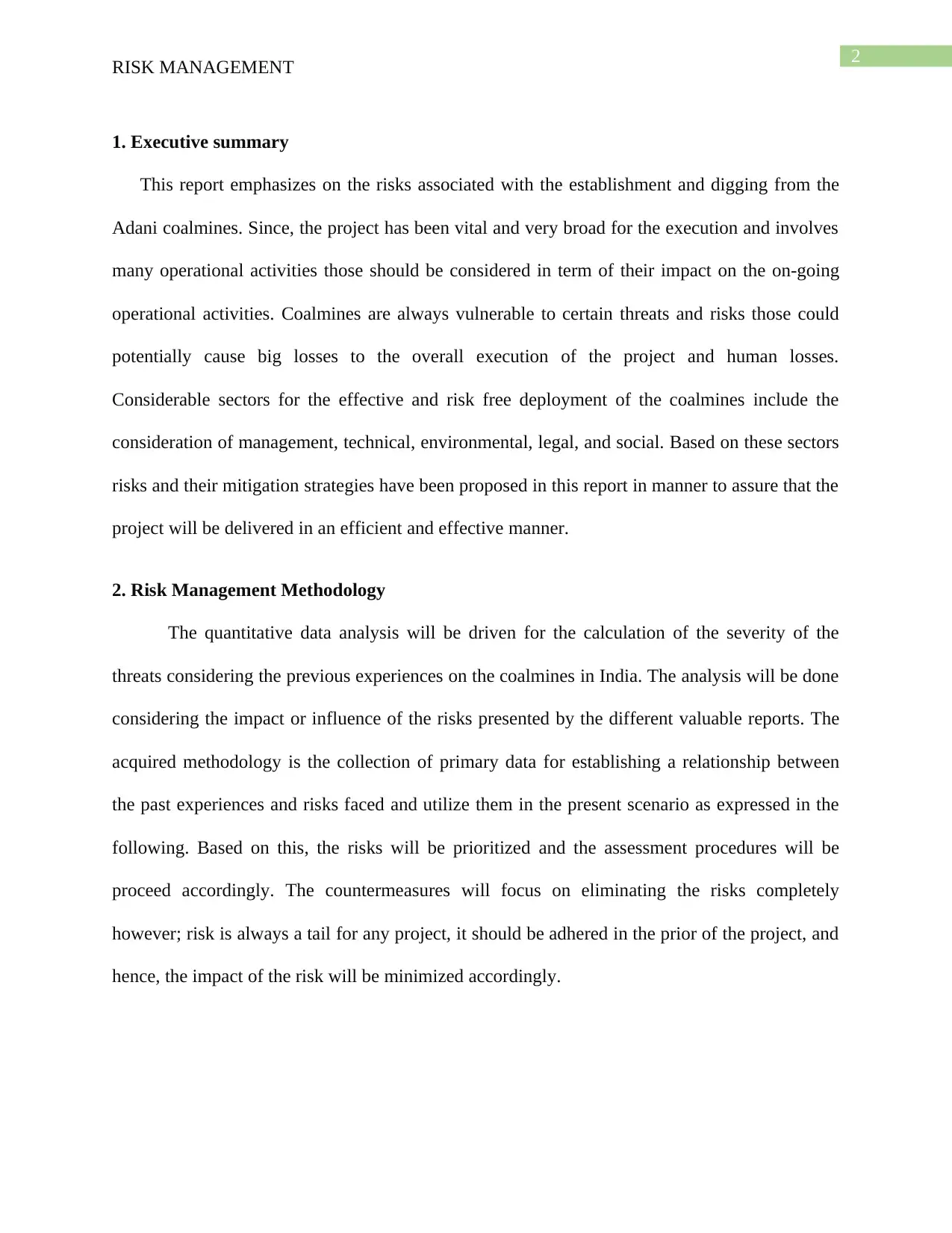
2
RISK MANAGEMENT
1. Executive summary
This report emphasizes on the risks associated with the establishment and digging from the
Adani coalmines. Since, the project has been vital and very broad for the execution and involves
many operational activities those should be considered in term of their impact on the on-going
operational activities. Coalmines are always vulnerable to certain threats and risks those could
potentially cause big losses to the overall execution of the project and human losses.
Considerable sectors for the effective and risk free deployment of the coalmines include the
consideration of management, technical, environmental, legal, and social. Based on these sectors
risks and their mitigation strategies have been proposed in this report in manner to assure that the
project will be delivered in an efficient and effective manner.
2. Risk Management Methodology
The quantitative data analysis will be driven for the calculation of the severity of the
threats considering the previous experiences on the coalmines in India. The analysis will be done
considering the impact or influence of the risks presented by the different valuable reports. The
acquired methodology is the collection of primary data for establishing a relationship between
the past experiences and risks faced and utilize them in the present scenario as expressed in the
following. Based on this, the risks will be prioritized and the assessment procedures will be
proceed accordingly. The countermeasures will focus on eliminating the risks completely
however; risk is always a tail for any project, it should be adhered in the prior of the project, and
hence, the impact of the risk will be minimized accordingly.
RISK MANAGEMENT
1. Executive summary
This report emphasizes on the risks associated with the establishment and digging from the
Adani coalmines. Since, the project has been vital and very broad for the execution and involves
many operational activities those should be considered in term of their impact on the on-going
operational activities. Coalmines are always vulnerable to certain threats and risks those could
potentially cause big losses to the overall execution of the project and human losses.
Considerable sectors for the effective and risk free deployment of the coalmines include the
consideration of management, technical, environmental, legal, and social. Based on these sectors
risks and their mitigation strategies have been proposed in this report in manner to assure that the
project will be delivered in an efficient and effective manner.
2. Risk Management Methodology
The quantitative data analysis will be driven for the calculation of the severity of the
threats considering the previous experiences on the coalmines in India. The analysis will be done
considering the impact or influence of the risks presented by the different valuable reports. The
acquired methodology is the collection of primary data for establishing a relationship between
the past experiences and risks faced and utilize them in the present scenario as expressed in the
following. Based on this, the risks will be prioritized and the assessment procedures will be
proceed accordingly. The countermeasures will focus on eliminating the risks completely
however; risk is always a tail for any project, it should be adhered in the prior of the project, and
hence, the impact of the risk will be minimized accordingly.
⊘ This is a preview!⊘
Do you want full access?
Subscribe today to unlock all pages.

Trusted by 1+ million students worldwide
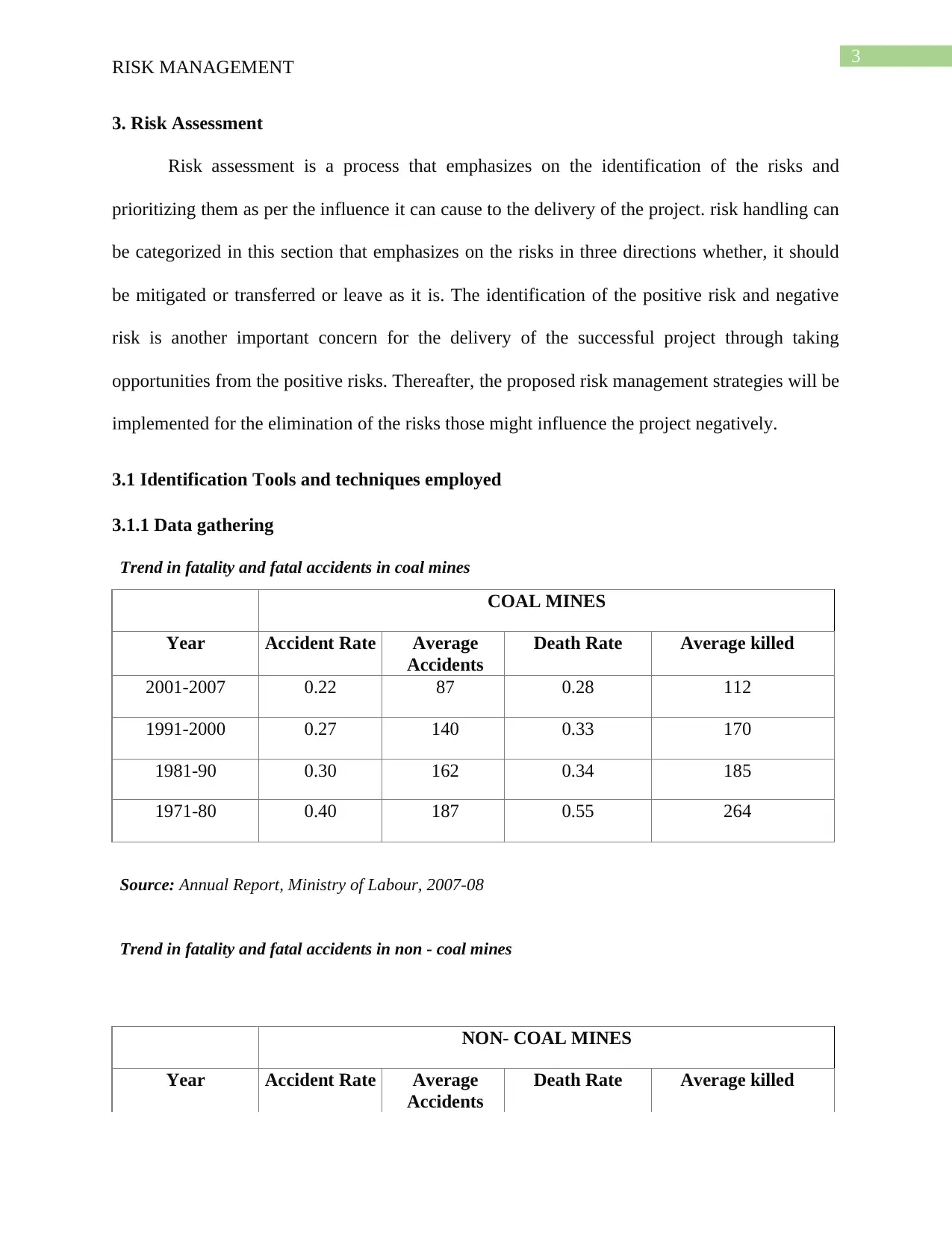
3
RISK MANAGEMENT
3. Risk Assessment
Risk assessment is a process that emphasizes on the identification of the risks and
prioritizing them as per the influence it can cause to the delivery of the project. risk handling can
be categorized in this section that emphasizes on the risks in three directions whether, it should
be mitigated or transferred or leave as it is. The identification of the positive risk and negative
risk is another important concern for the delivery of the successful project through taking
opportunities from the positive risks. Thereafter, the proposed risk management strategies will be
implemented for the elimination of the risks those might influence the project negatively.
3.1 Identification Tools and techniques employed
3.1.1 Data gathering
Trend in fatality and fatal accidents in coal mines
COAL MINES
Year Accident Rate Average
Accidents
Death Rate Average killed
2001-2007 0.22 87 0.28 112
1991-2000 0.27 140 0.33 170
1981-90 0.30 162 0.34 185
1971-80 0.40 187 0.55 264
Source: Annual Report, Ministry of Labour, 2007-08
Trend in fatality and fatal accidents in non - coal mines
NON- COAL MINES
Year Accident Rate Average
Accidents
Death Rate Average killed
RISK MANAGEMENT
3. Risk Assessment
Risk assessment is a process that emphasizes on the identification of the risks and
prioritizing them as per the influence it can cause to the delivery of the project. risk handling can
be categorized in this section that emphasizes on the risks in three directions whether, it should
be mitigated or transferred or leave as it is. The identification of the positive risk and negative
risk is another important concern for the delivery of the successful project through taking
opportunities from the positive risks. Thereafter, the proposed risk management strategies will be
implemented for the elimination of the risks those might influence the project negatively.
3.1 Identification Tools and techniques employed
3.1.1 Data gathering
Trend in fatality and fatal accidents in coal mines
COAL MINES
Year Accident Rate Average
Accidents
Death Rate Average killed
2001-2007 0.22 87 0.28 112
1991-2000 0.27 140 0.33 170
1981-90 0.30 162 0.34 185
1971-80 0.40 187 0.55 264
Source: Annual Report, Ministry of Labour, 2007-08
Trend in fatality and fatal accidents in non - coal mines
NON- COAL MINES
Year Accident Rate Average
Accidents
Death Rate Average killed
Paraphrase This Document
Need a fresh take? Get an instant paraphrase of this document with our AI Paraphraser
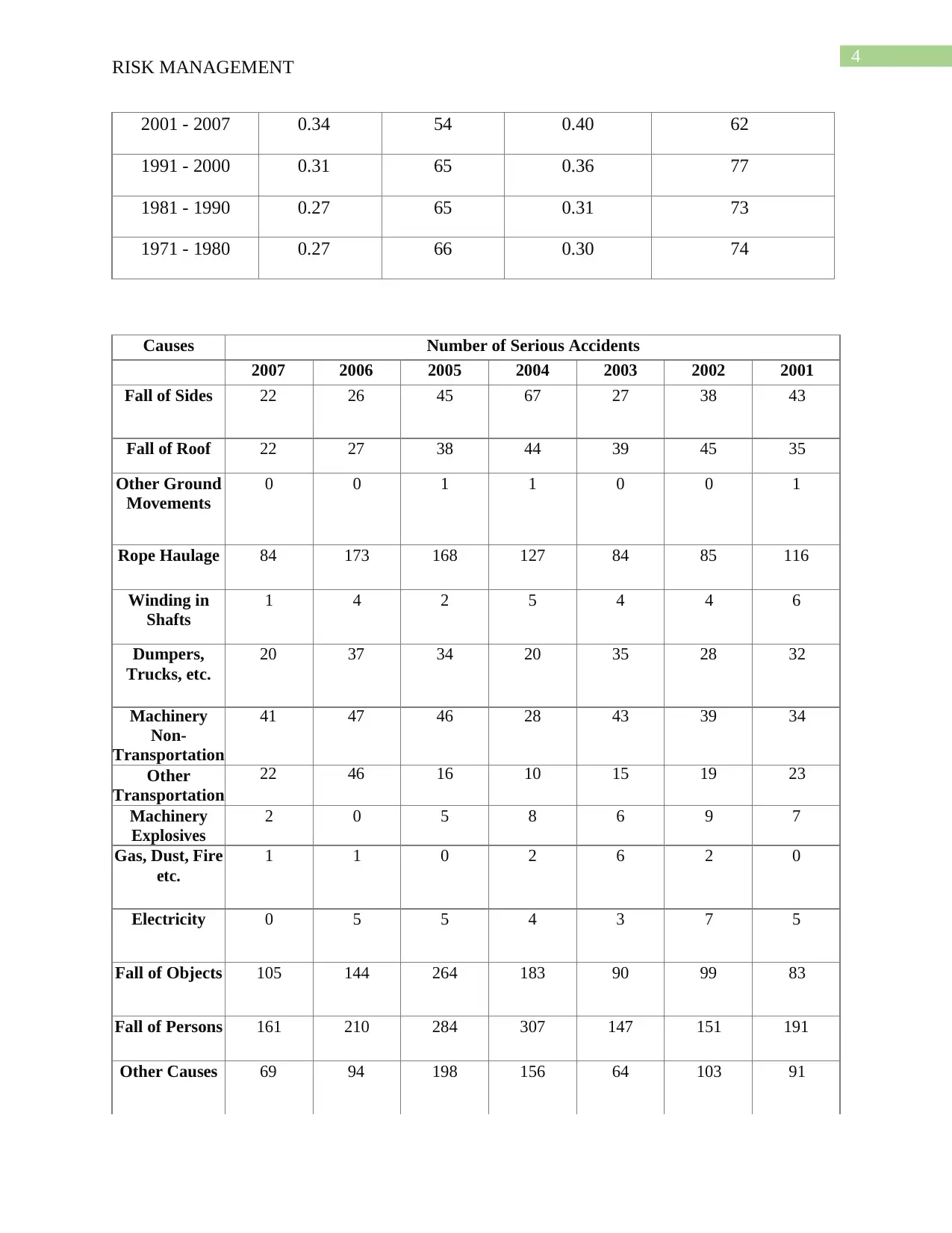
4
RISK MANAGEMENT
2001 - 2007 0.34 54 0.40 62
1991 - 2000 0.31 65 0.36 77
1981 - 1990 0.27 65 0.31 73
1971 - 1980 0.27 66 0.30 74
Causes Number of Serious Accidents
2007 2006 2005 2004 2003 2002 2001
Fall of Sides 22 26 45 67 27 38 43
Fall of Roof 22 27 38 44 39 45 35
Other Ground
Movements
0 0 1 1 0 0 1
Rope Haulage 84 173 168 127 84 85 116
Winding in
Shafts
1 4 2 5 4 4 6
Dumpers,
Trucks, etc.
20 37 34 20 35 28 32
Machinery
Non-
Transportation
41 47 46 28 43 39 34
Other
Transportation
22 46 16 10 15 19 23
Machinery
Explosives
2 0 5 8 6 9 7
Gas, Dust, Fire
etc.
1 1 0 2 6 2 0
Electricity 0 5 5 4 3 7 5
Fall of Objects 105 144 264 183 90 99 83
Fall of Persons 161 210 284 307 147 151 191
Other Causes 69 94 198 156 64 103 91
RISK MANAGEMENT
2001 - 2007 0.34 54 0.40 62
1991 - 2000 0.31 65 0.36 77
1981 - 1990 0.27 65 0.31 73
1971 - 1980 0.27 66 0.30 74
Causes Number of Serious Accidents
2007 2006 2005 2004 2003 2002 2001
Fall of Sides 22 26 45 67 27 38 43
Fall of Roof 22 27 38 44 39 45 35
Other Ground
Movements
0 0 1 1 0 0 1
Rope Haulage 84 173 168 127 84 85 116
Winding in
Shafts
1 4 2 5 4 4 6
Dumpers,
Trucks, etc.
20 37 34 20 35 28 32
Machinery
Non-
Transportation
41 47 46 28 43 39 34
Other
Transportation
22 46 16 10 15 19 23
Machinery
Explosives
2 0 5 8 6 9 7
Gas, Dust, Fire
etc.
1 1 0 2 6 2 0
Electricity 0 5 5 4 3 7 5
Fall of Objects 105 144 264 183 90 99 83
Fall of Persons 161 210 284 307 147 151 191
Other Causes 69 94 198 156 64 103 91
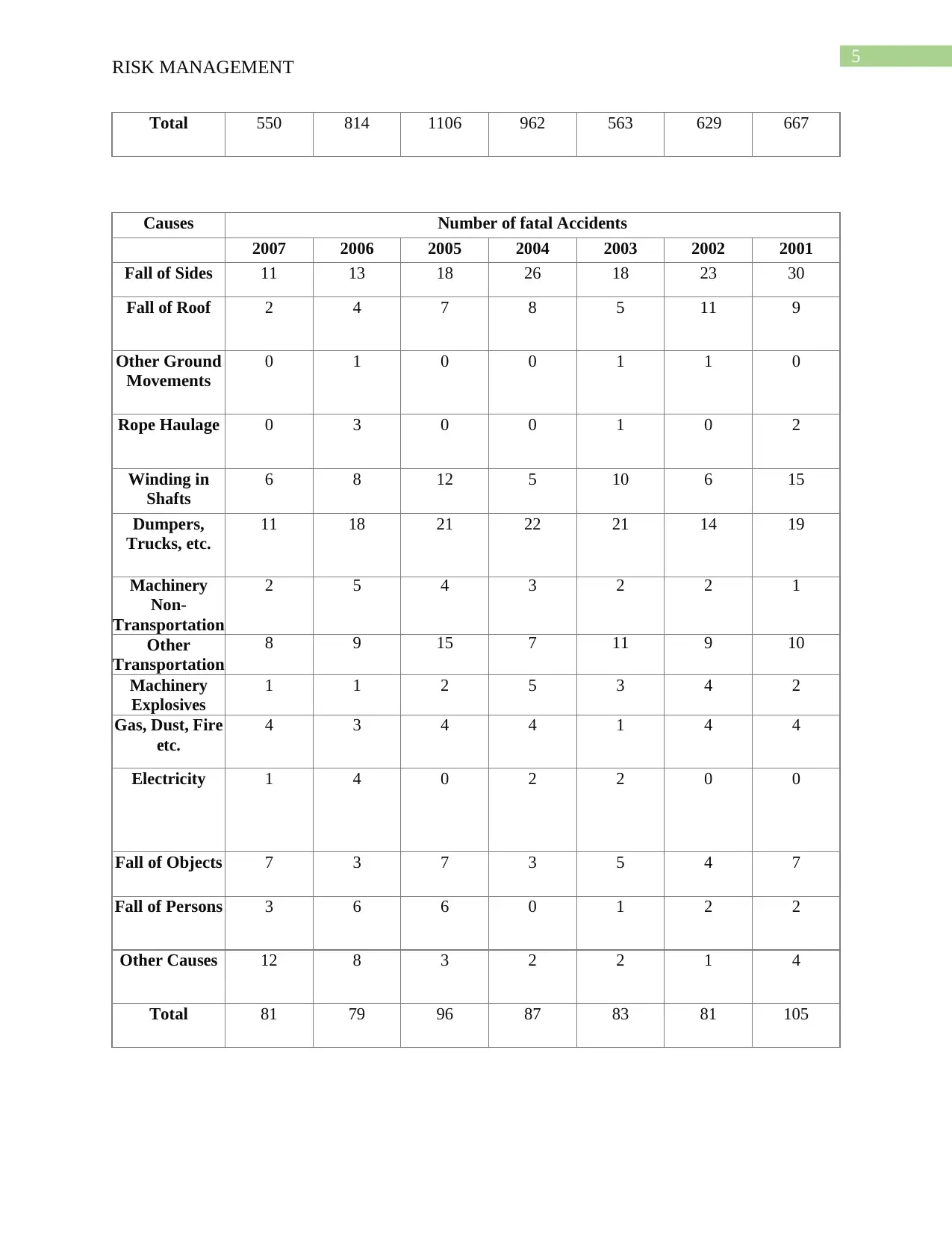
5
RISK MANAGEMENT
Total 550 814 1106 962 563 629 667
Causes Number of fatal Accidents
2007 2006 2005 2004 2003 2002 2001
Fall of Sides 11 13 18 26 18 23 30
Fall of Roof 2 4 7 8 5 11 9
Other Ground
Movements
0 1 0 0 1 1 0
Rope Haulage 0 3 0 0 1 0 2
Winding in
Shafts
6 8 12 5 10 6 15
Dumpers,
Trucks, etc.
11 18 21 22 21 14 19
Machinery
Non-
Transportation
2 5 4 3 2 2 1
Other
Transportation
8 9 15 7 11 9 10
Machinery
Explosives
1 1 2 5 3 4 2
Gas, Dust, Fire
etc.
4 3 4 4 1 4 4
Electricity 1 4 0 2 2 0 0
Fall of Objects 7 3 7 3 5 4 7
Fall of Persons 3 6 6 0 1 2 2
Other Causes 12 8 3 2 2 1 4
Total 81 79 96 87 83 81 105
RISK MANAGEMENT
Total 550 814 1106 962 563 629 667
Causes Number of fatal Accidents
2007 2006 2005 2004 2003 2002 2001
Fall of Sides 11 13 18 26 18 23 30
Fall of Roof 2 4 7 8 5 11 9
Other Ground
Movements
0 1 0 0 1 1 0
Rope Haulage 0 3 0 0 1 0 2
Winding in
Shafts
6 8 12 5 10 6 15
Dumpers,
Trucks, etc.
11 18 21 22 21 14 19
Machinery
Non-
Transportation
2 5 4 3 2 2 1
Other
Transportation
8 9 15 7 11 9 10
Machinery
Explosives
1 1 2 5 3 4 2
Gas, Dust, Fire
etc.
4 3 4 4 1 4 4
Electricity 1 4 0 2 2 0 0
Fall of Objects 7 3 7 3 5 4 7
Fall of Persons 3 6 6 0 1 2 2
Other Causes 12 8 3 2 2 1 4
Total 81 79 96 87 83 81 105
⊘ This is a preview!⊘
Do you want full access?
Subscribe today to unlock all pages.

Trusted by 1+ million students worldwide
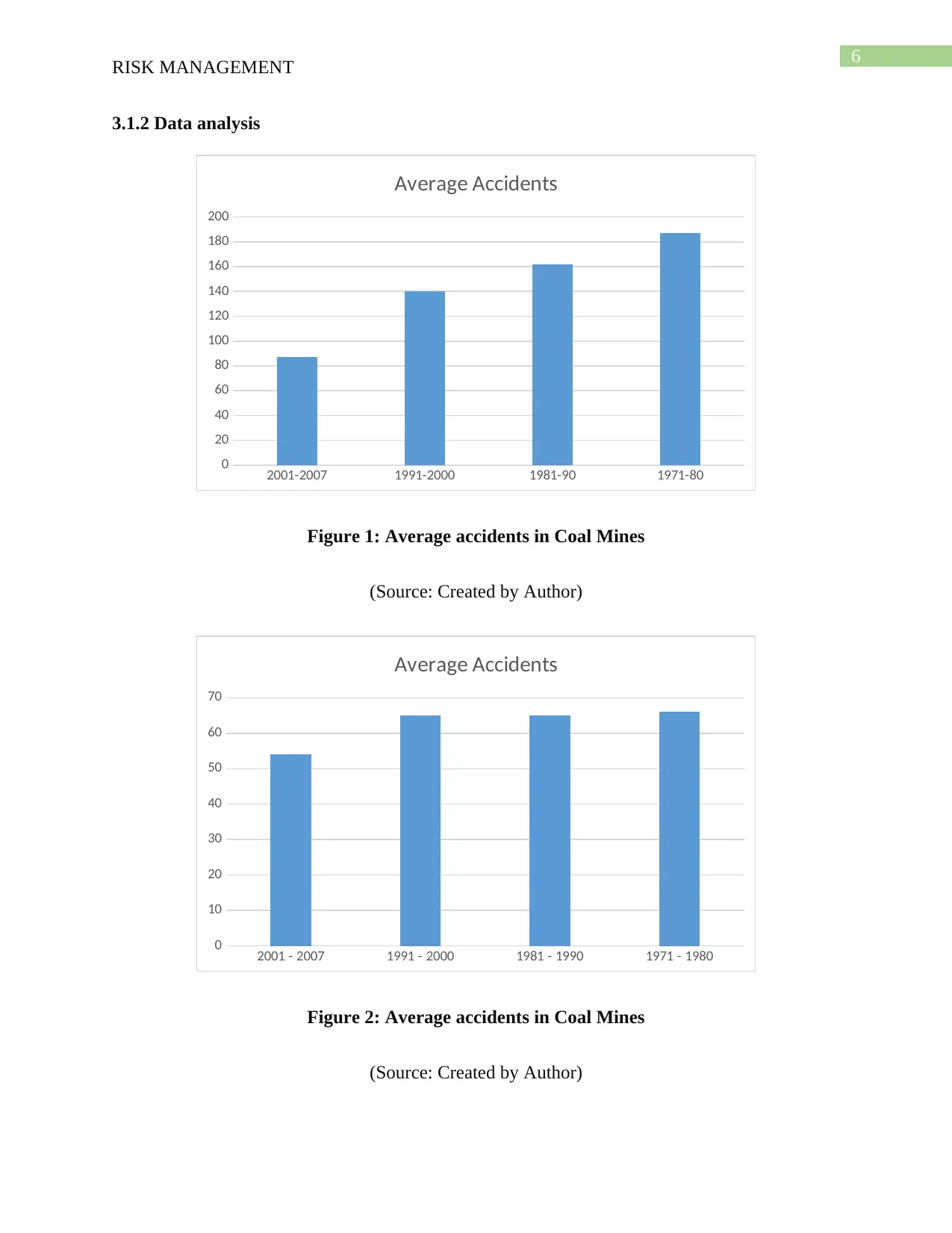
6
RISK MANAGEMENT
3.1.2 Data analysis
2001-2007 1991-2000 1981-90 1971-80
0
20
40
60
80
100
120
140
160
180
200
Average Accidents
Figure 1: Average accidents in Coal Mines
(Source: Created by Author)
2001 - 2007 1991 - 2000 1981 - 1990 1971 - 1980
0
10
20
30
40
50
60
70
Average Accidents
Figure 2: Average accidents in Coal Mines
(Source: Created by Author)
RISK MANAGEMENT
3.1.2 Data analysis
2001-2007 1991-2000 1981-90 1971-80
0
20
40
60
80
100
120
140
160
180
200
Average Accidents
Figure 1: Average accidents in Coal Mines
(Source: Created by Author)
2001 - 2007 1991 - 2000 1981 - 1990 1971 - 1980
0
10
20
30
40
50
60
70
Average Accidents
Figure 2: Average accidents in Coal Mines
(Source: Created by Author)
Paraphrase This Document
Need a fresh take? Get an instant paraphrase of this document with our AI Paraphraser
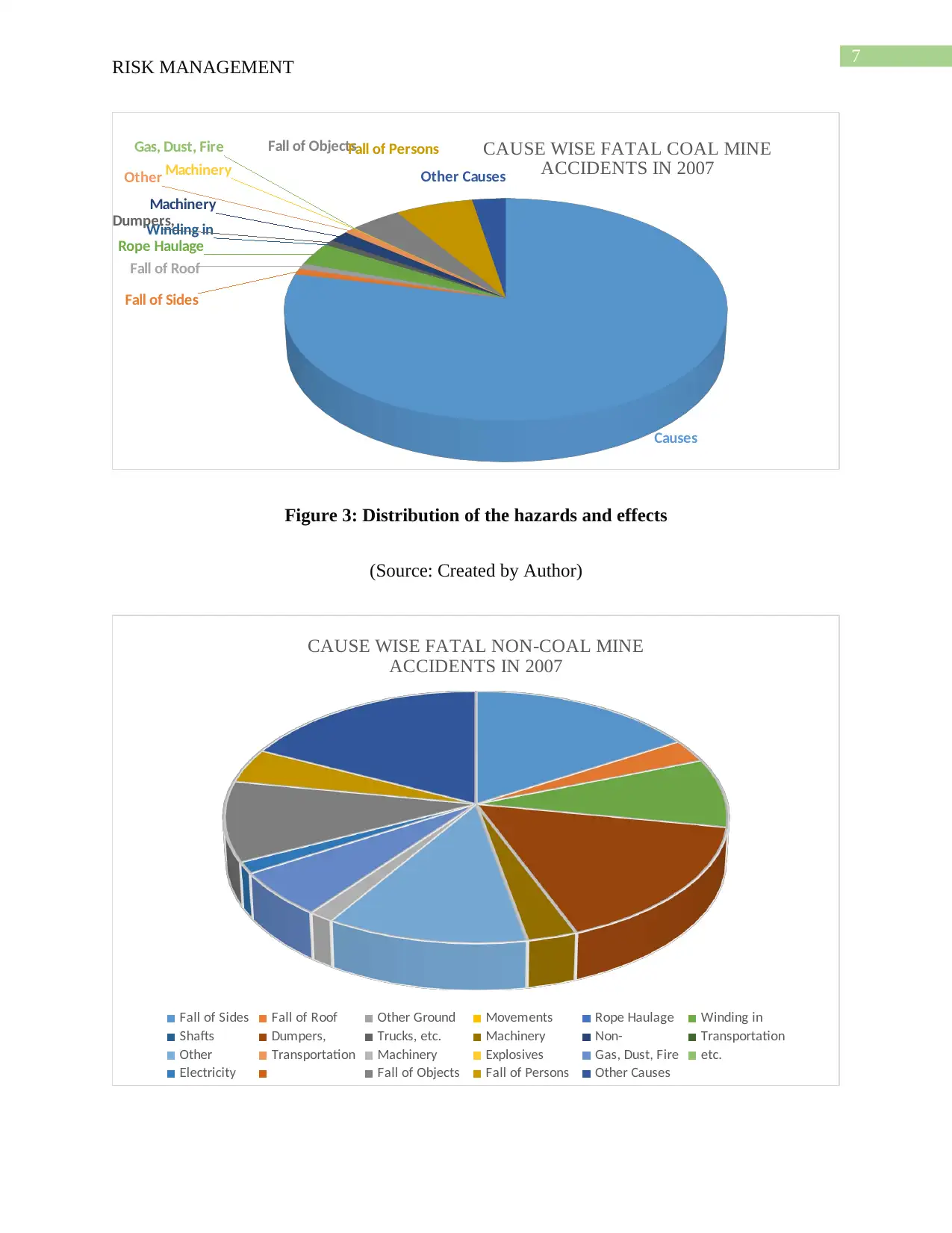
7
RISK MANAGEMENT
Causes
Fall of Sides
Fall of Roof
Rope Haulage
Winding in
Dumpers,
Machinery
Other Machinery
Gas, Dust, Fire Fall of ObjectsFall of Persons
Other Causes
CAUSE WISE FATAL COAL MINE
ACCIDENTS IN 2007
Figure 3: Distribution of the hazards and effects
(Source: Created by Author)
CAUSE WISE FATAL NON-COAL MINE
ACCIDENTS IN 2007
Fall of Sides Fall of Roof Other Ground Movements Rope Haulage Winding in
Shafts Dumpers, Trucks, etc. Machinery Non- Transportation
Other Transportation Machinery Explosives Gas, Dust, Fire etc.
Electricity Fall of Objects Fall of Persons Other Causes
RISK MANAGEMENT
Causes
Fall of Sides
Fall of Roof
Rope Haulage
Winding in
Dumpers,
Machinery
Other Machinery
Gas, Dust, Fire Fall of ObjectsFall of Persons
Other Causes
CAUSE WISE FATAL COAL MINE
ACCIDENTS IN 2007
Figure 3: Distribution of the hazards and effects
(Source: Created by Author)
CAUSE WISE FATAL NON-COAL MINE
ACCIDENTS IN 2007
Fall of Sides Fall of Roof Other Ground Movements Rope Haulage Winding in
Shafts Dumpers, Trucks, etc. Machinery Non- Transportation
Other Transportation Machinery Explosives Gas, Dust, Fire etc.
Electricity Fall of Objects Fall of Persons Other Causes
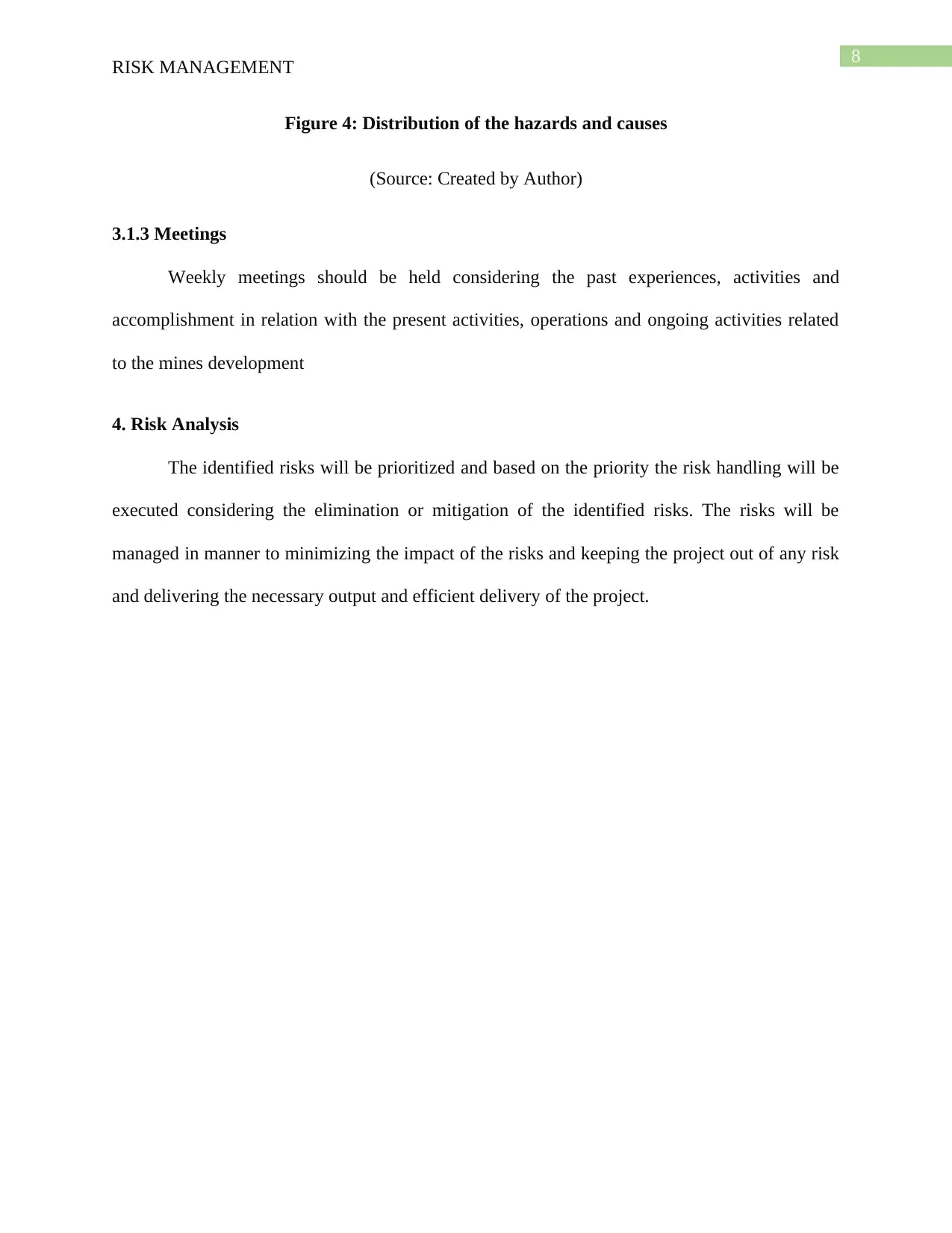
8
RISK MANAGEMENT
Figure 4: Distribution of the hazards and causes
(Source: Created by Author)
3.1.3 Meetings
Weekly meetings should be held considering the past experiences, activities and
accomplishment in relation with the present activities, operations and ongoing activities related
to the mines development
4. Risk Analysis
The identified risks will be prioritized and based on the priority the risk handling will be
executed considering the elimination or mitigation of the identified risks. The risks will be
managed in manner to minimizing the impact of the risks and keeping the project out of any risk
and delivering the necessary output and efficient delivery of the project.
RISK MANAGEMENT
Figure 4: Distribution of the hazards and causes
(Source: Created by Author)
3.1.3 Meetings
Weekly meetings should be held considering the past experiences, activities and
accomplishment in relation with the present activities, operations and ongoing activities related
to the mines development
4. Risk Analysis
The identified risks will be prioritized and based on the priority the risk handling will be
executed considering the elimination or mitigation of the identified risks. The risks will be
managed in manner to minimizing the impact of the risks and keeping the project out of any risk
and delivering the necessary output and efficient delivery of the project.
⊘ This is a preview!⊘
Do you want full access?
Subscribe today to unlock all pages.

Trusted by 1+ million students worldwide
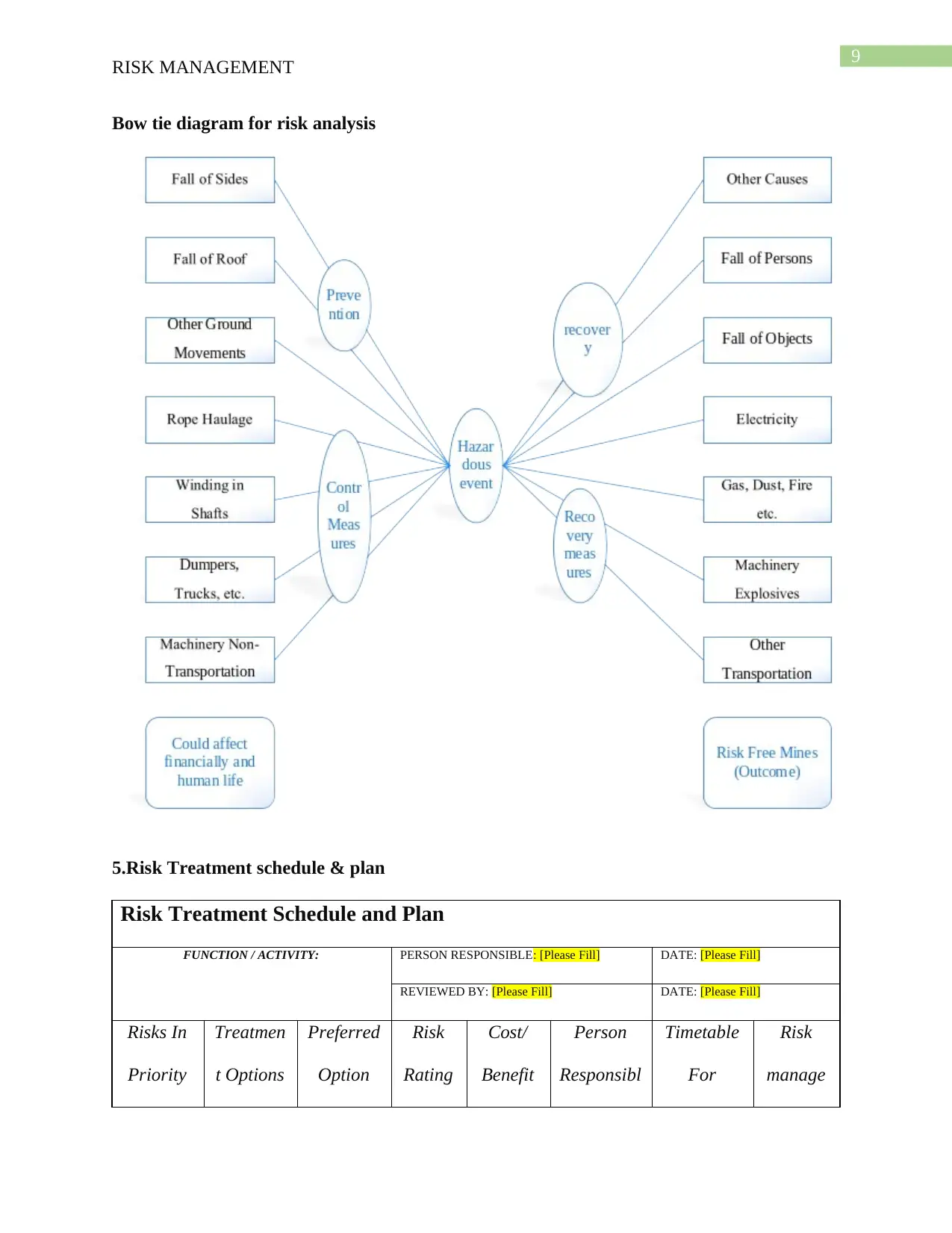
9
RISK MANAGEMENT
Bow tie diagram for risk analysis
5.Risk Treatment schedule & plan
Risk Treatment Schedule and Plan
FUNCTION / ACTIVITY: PERSON RESPONSIBLE: [Please Fill] DATE: [Please Fill]
REVIEWED BY: [Please Fill] DATE: [Please Fill]
Risks In
Priority
Treatmen
t Options
Preferred
Option
Risk
Rating
Cost/
Benefit
Person
Responsibl
Timetable
For
Risk
manage
RISK MANAGEMENT
Bow tie diagram for risk analysis
5.Risk Treatment schedule & plan
Risk Treatment Schedule and Plan
FUNCTION / ACTIVITY: PERSON RESPONSIBLE: [Please Fill] DATE: [Please Fill]
REVIEWED BY: [Please Fill] DATE: [Please Fill]
Risks In
Priority
Treatmen
t Options
Preferred
Option
Risk
Rating
Cost/
Benefit
Person
Responsibl
Timetable
For
Risk
manage
Paraphrase This Document
Need a fresh take? Get an instant paraphrase of this document with our AI Paraphraser
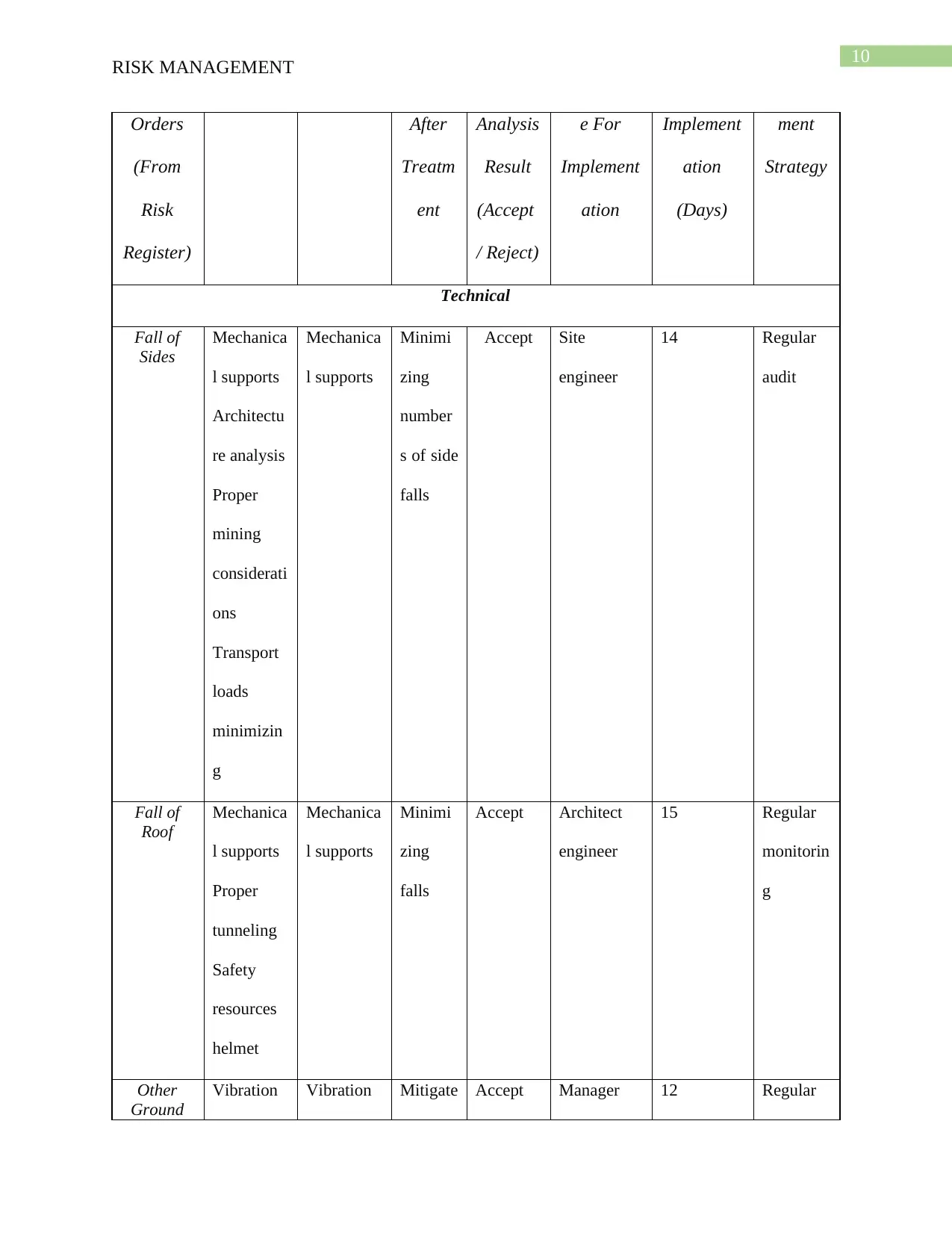
10
RISK MANAGEMENT
Orders
(From
Risk
Register)
After
Treatm
ent
Analysis
Result
(Accept
/ Reject)
e For
Implement
ation
Implement
ation
(Days)
ment
Strategy
Technical
Fall of
Sides
Mechanica
l supports
Architectu
re analysis
Proper
mining
considerati
ons
Transport
loads
minimizin
g
Mechanica
l supports
Minimi
zing
number
s of side
falls
Accept Site
engineer
14 Regular
audit
Fall of
Roof
Mechanica
l supports
Proper
tunneling
Safety
resources
helmet
Mechanica
l supports
Minimi
zing
falls
Accept Architect
engineer
15 Regular
monitorin
g
Other
Ground
Vibration Vibration Mitigate Accept Manager 12 Regular
RISK MANAGEMENT
Orders
(From
Risk
Register)
After
Treatm
ent
Analysis
Result
(Accept
/ Reject)
e For
Implement
ation
Implement
ation
(Days)
ment
Strategy
Technical
Fall of
Sides
Mechanica
l supports
Architectu
re analysis
Proper
mining
considerati
ons
Transport
loads
minimizin
g
Mechanica
l supports
Minimi
zing
number
s of side
falls
Accept Site
engineer
14 Regular
audit
Fall of
Roof
Mechanica
l supports
Proper
tunneling
Safety
resources
helmet
Mechanica
l supports
Minimi
zing
falls
Accept Architect
engineer
15 Regular
monitorin
g
Other
Ground
Vibration Vibration Mitigate Accept Manager 12 Regular
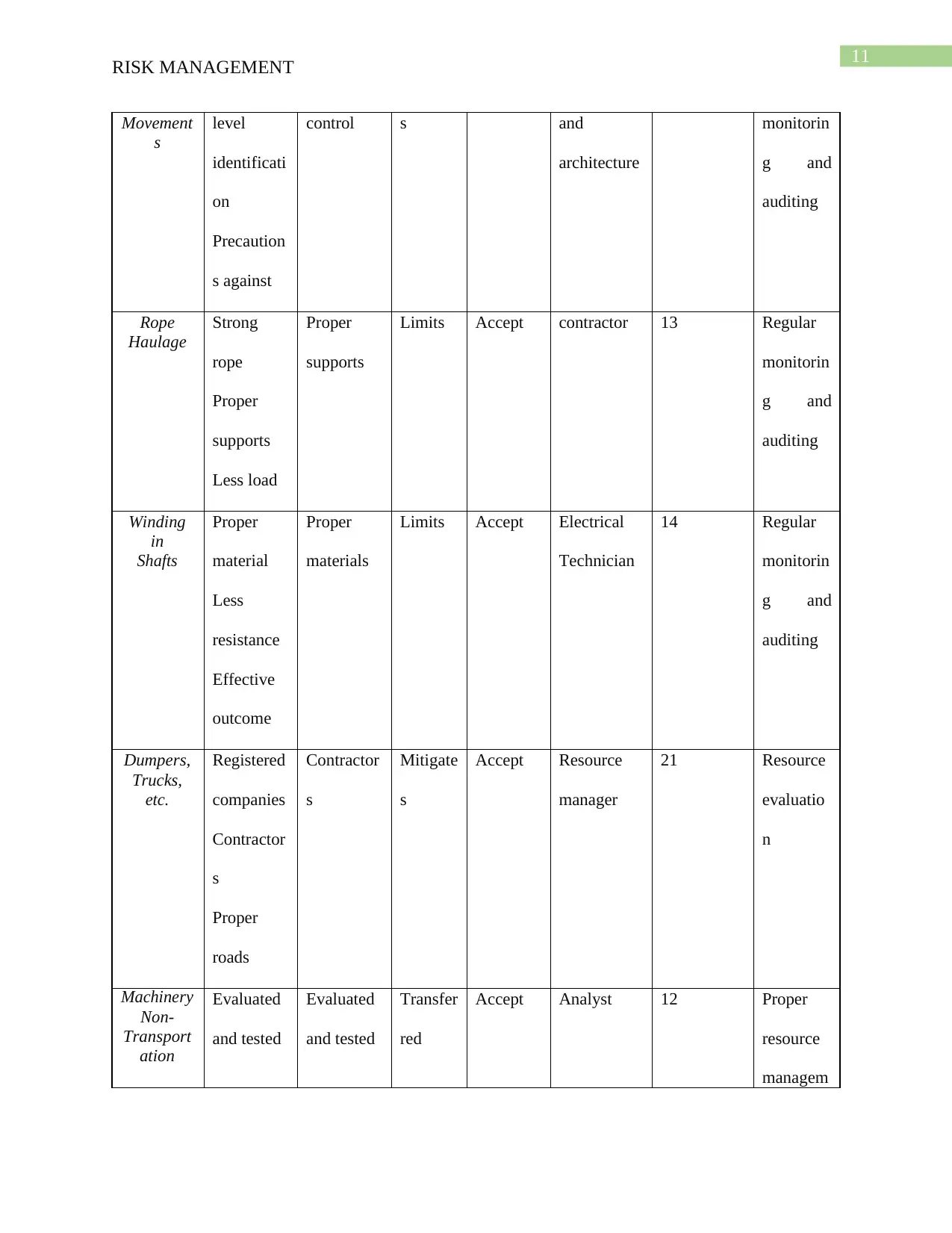
11
RISK MANAGEMENT
Movement
s
level
identificati
on
Precaution
s against
control s and
architecture
monitorin
g and
auditing
Rope
Haulage
Strong
rope
Proper
supports
Less load
Proper
supports
Limits Accept contractor 13 Regular
monitorin
g and
auditing
Winding
in
Shafts
Proper
material
Less
resistance
Effective
outcome
Proper
materials
Limits Accept Electrical
Technician
14 Regular
monitorin
g and
auditing
Dumpers,
Trucks,
etc.
Registered
companies
Contractor
s
Proper
roads
Contractor
s
Mitigate
s
Accept Resource
manager
21 Resource
evaluatio
n
Machinery
Non-
Transport
ation
Evaluated
and tested
Evaluated
and tested
Transfer
red
Accept Analyst 12 Proper
resource
managem
RISK MANAGEMENT
Movement
s
level
identificati
on
Precaution
s against
control s and
architecture
monitorin
g and
auditing
Rope
Haulage
Strong
rope
Proper
supports
Less load
Proper
supports
Limits Accept contractor 13 Regular
monitorin
g and
auditing
Winding
in
Shafts
Proper
material
Less
resistance
Effective
outcome
Proper
materials
Limits Accept Electrical
Technician
14 Regular
monitorin
g and
auditing
Dumpers,
Trucks,
etc.
Registered
companies
Contractor
s
Proper
roads
Contractor
s
Mitigate
s
Accept Resource
manager
21 Resource
evaluatio
n
Machinery
Non-
Transport
ation
Evaluated
and tested
Evaluated
and tested
Transfer
red
Accept Analyst 12 Proper
resource
managem
⊘ This is a preview!⊘
Do you want full access?
Subscribe today to unlock all pages.

Trusted by 1+ million students worldwide
1 out of 20
Your All-in-One AI-Powered Toolkit for Academic Success.
+13062052269
info@desklib.com
Available 24*7 on WhatsApp / Email
![[object Object]](/_next/static/media/star-bottom.7253800d.svg)
Unlock your academic potential
Copyright © 2020–2025 A2Z Services. All Rights Reserved. Developed and managed by ZUCOL.


